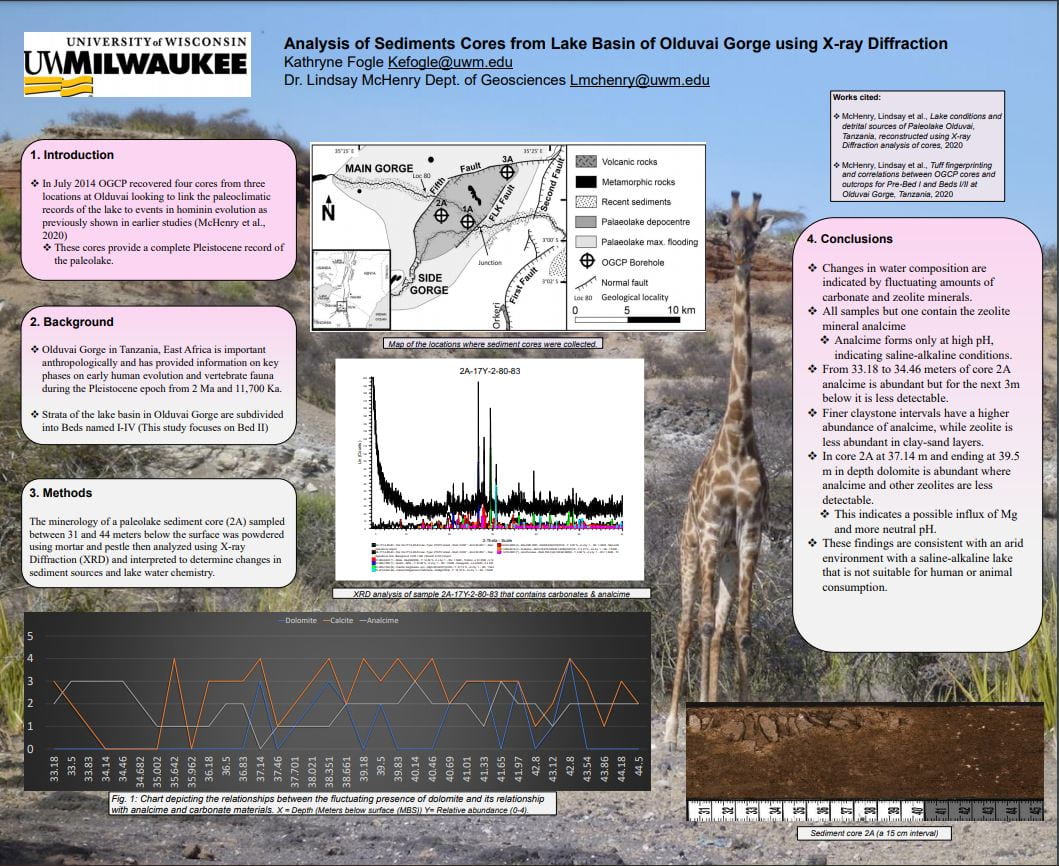Kathryne Fogle, “Analysis of Sediments Cores from Lake Basin of Olduvai Using X-ray Diffraction”
Mentor: Lindsay McHenry, Geosciences
Olduvai Gorge in Tanzania, East Africa is important anthropologically and has provided information on key phases on early human evolution and vertebrate fauna during the Pleistocene epoch from 2 Ma and 11,700 Ka[LJMI] and also hosted a lake during most of its history. The mineralogy of a paleolake sediment core (2A) sampled between 31 and 44 meters below the surface was analyzed using X-ray Diffraction (XRD) and interpreted to determine changes in sediment sources and lake water chemistry. Changes in water composition are indicated by fluctuating amounts of carbonate materials. All samples but one contain the zeolite mineral analcime and its fluctuating abundance indicate changes in water chemistry. From 33.18 to 34.46 meters of core 2A analcime is abundant but for the next 3m above it is less detectable. Finer claystone intervals seem to have a higher abundance in analcime, while zeolite is less abundant in clay-sand layers. In core 2A at 37.14 m and ending at 39.5 m in depth dolomite is abundant where analcime and other zeolites are less detectable, which may indicate a possible influx of Mg and lower pH. These findings are consistent with an arid environment with a saline-alkaline lake that is not suitable for human or animal consumption as high Ph and salinity are required to produce analcime.
Click the thumbnail below to open the full sized poster in a new tab.

I love how this turned out! It’s interesting to me how often the calcite and dolomite don’t co-vary. I’d expect dolomite to replace calcite (and thus be more abundant in samples that contain less calcite) but you have samples that are high in both! This is an interesting paleo-lake. I think our next step could be to compare these samples against the detailed sedimentology of the core from the core logs and from the Stanistreet et al. papers, to see how these tracers of lake chemistry compare against their facies determinations. I can get you those logs.
Aesthetically, I love how you worked around the giraffe in the background pic. Classic!
I am actually writing a research paper for my sed-strat class that compares his papers on sedimentology and stratigraphy of the area compared to your XRD and tuff analysis papers published last year. I will make sure to send it to you when I am done!
Nice poster, Kathryne! Do you think the shifts in pH are related to climactic shifts? Or something else? (I also like the giraffe 🙂
In this situation, it appears that higher zeolite abundance correlates with higher lake levels. And the ratio of zeolite to k-feldspar also indicates the condition, with low zeolite and k-feldspar indicating fresher conditions, high zeolite and low k-feldspar indicating an intermediate level of alkalinity, both high zeolite and k-feldspar indicating very high alkaline levels, and low zeolite with very high k-feldspar being the highest!
These also correlate with conditions being wetter, intermediate, dry, and dryest conditions respectively
Nice job, Kathryne! Are there any modern lakes that have the same chemistry?
What an interesting topic! Great to see you layout the data. I was curious on how does the interpretation of the lake chemistry compare to earlier or later intervals. As Julie noted, I like the giraffe.
In a small section on the core there was a shift where dolomite became prevalent and zeolite became sparse, this only happened in two intervals (37.7-38.16 mbs and 40.68-42.8 mbs). Other than these two intervals, there was no dolomite detected in any of the samples.
Nice job Kathryne. Do you know if there is a relationship in time between the core you sampled and decreased hominid activity in the gorge?
Great job Kathryne! Were there other lakes nearby that might have provided drinkable water for hominids?